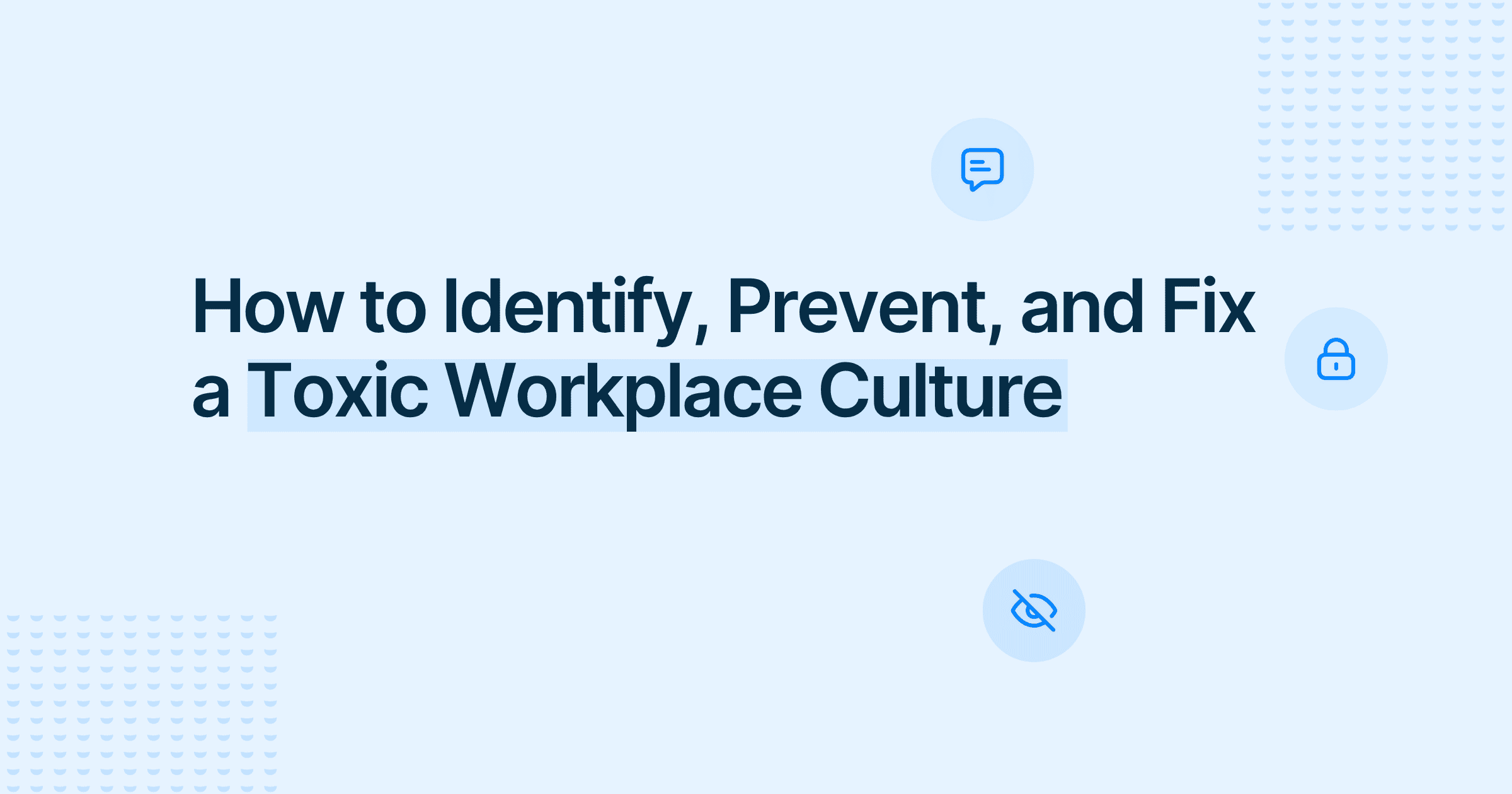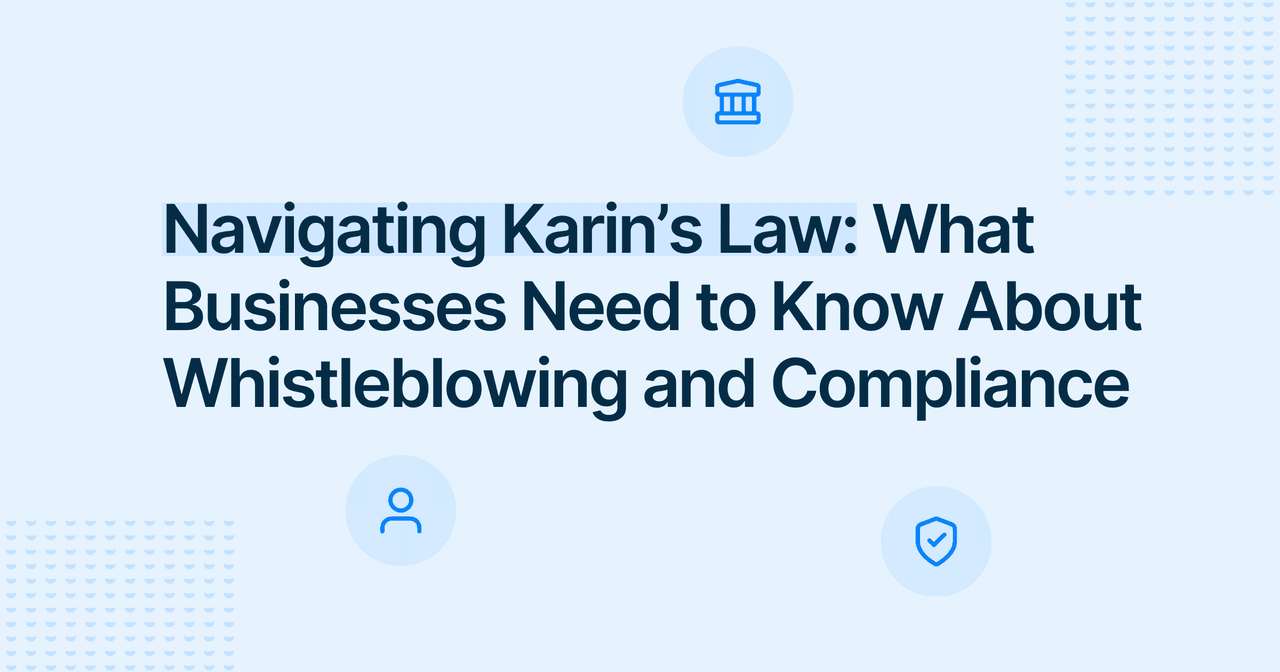



Discover the benefits of a transparent organization!
Try our free platform and strengthen the culture of openness in your team.
Workplace Environment

Yeva Bartkiv
Copywriter
Published
2025-07-30
Reading time
6 min


Table of contents
Subscribe to our newsletter
A toxic workplace culture doesn’t just affect a few people - it infects the entire organization. It shows up as burnout, disengagement, high turnover, and a steady decline in both morale and performance. Over time, it erodes your company’s reputation, team trust, and bottom line.

The tricky part? Toxicity often builds slowly. Leaders may miss the early warning signs while they’re focused on hitting targets or managing daily operations. And employees? Many stay silent. They fear retaliation, don’t think it’s worth the risk, or feel no one will listen anyway.
But silence doesn’t equal safety - it just lets the problem grow. That’s why it’s critical to recognize, prevent, and take action against toxic work environments before they become your company’s norm.
A toxic workplace isn’t always loud or chaotic. Sometimes it’s quiet - a culture of fear, favoritism, or indifference that makes people feel unsupported, excluded, or invisible.
In practical terms, a toxic work culture means an environment where harmful behaviors are tolerated or ignored. It often shows up through micromanagement, bullying, cliques, or unethical decision-making.
It could look like managers who ignore misconduct, or team members who feel they can’t share ideas without being dismissed. Or maybe it’s a culture where speaking up leads to being sidelined - or quietly pushed out.
All of these reflect a breakdown in organizational culture, psychological safety, and trust. And they can lead to serious consequences for both employee well-being and company performance.
Recognizing the signs of a toxic workplace early is crucial. The longer these red flags are ignored, the more complex the culture is to repair.
You might start seeing a spike in absenteeism or hear comments like “nothing ever changes.” You’ll notice teams working in silos, avoiding collaboration, or relying on office gossip instead of transparent communication.
Trust starts to fade. Good people leave quietly. And those who stay begin to disengage. Watch for these common indicators:
A toxic environment doesn’t have to be dramatic to be destructive - sometimes it’s just the weight of feeling undervalued, overworked, and unheard.
You might think a few difficult personalities or high-pressure habits are just part of the job. But left unaddressed, toxicity creates ripple effects that impact everything - from daily work to long-term strategy.

Research from MIT Sloan found that toxic workplace culture is the number one reason employees quit, more than pay, workload, or lack of flexibility.
And it gets expensive. Toxicity leads to rising health care claims, declining productivity, and a damaged reputation that makes it harder to attract top talent. You’ll also see a sharp drop in employee morale, along with legal risks if ethical lines are crossed.
The negative impact hits your people first. But eventually, it hits your numbers, too.
If your culture is still healthy, protect it. If you’re starting to see cracks, act quickly. Prevention begins with clarity. Make your core values visible, not just on paper but in everyday actions. Leaders must model respect, empathy, and accountability in every interaction.
Encourage regular employee feedback, not just annual surveys. Create opportunities for people to voice concerns without fear. That could mean skip-level check-ins, anonymous tools like FaceUp, or safe-space team forums.
Training plays a role, too. Managers should be equipped to spot early toxic behaviors - things like micromanagement, cliques, or silent treatment - and respond with confidence and compassion.
Also, prioritize well-being. Protecting work-life balance, promoting mental health, and preventing burnout are not just wellness perks - they’re core to maintaining a healthy workplace.

And when things do go wrong, act. One of the most significant contributors to toxic culture in the workplace is leadership ignoring problems or protecting toxic high performers.
Maybe the damage has already been done. Maybe people are burned out, teams are fractured, and trust is running low. Here’s how to fix it - one step at a time.
Start by acknowledging the problem. Denial only deepens the divide. Own it. Say what went wrong. And share how you plan to rebuild.
Then take meaningful action. Remove barriers to speaking up. Revisit and reinforce your organizational culture. Address toxic employees - even if they’re “top performers.” Rebuild norms that prioritize inclusion, fairness, and respect.
Most importantly, involve your people. Let your team members shape the new path forward. Empower them to hold each other - and their leaders - accountable. Culture repair is never quick. But with consistent action, transparency, and the right tools, it’s possible.
Tools like FaceUp can guide this process by enabling anonymous reports, spotting hidden risks, and tracking change over time. It makes turning the corner easier - and safer for everyone.
Sometimes, toxicity is concentrated in a few individuals. If someone consistently undermines others, breaks boundaries, or creates fear, it’s time to act. Begin with documentation - specifics matter. Follow up with feedback and clear expectations. If behavior doesn’t change, escalate appropriately.
Letting one person poison the entire team sends the wrong message - that poor behavior gets a pass. That doesn’t mean abandoning empathy. But it does mean standing firm in your values and protecting the larger team from continued harm.
Read more about ganging up at work.
One of the most complex parts of dealing with a toxic workplace is that many people suffer in silence.
They fear retaliation. They’ve seen others speak up and get ignored. Or they’ve learned that HR is too close to leadership to feel neutral. That’s why anonymous reporting is essential, not optional. FaceUp provides a simple, secure way for employees to report toxic behaviors, harassment, or ethical violations without fear. It helps organizations gather the insight they need, without putting employees at risk.
To understand what drives reporting (and silence), read more in What Behavior Do Whistleblowers Most Often Report.
Toxic culture doesn’t change with a one-off workshop or leadership memo. It takes daily decisions and collective ownership.
That means making psychological safety part of every interaction. It means recognizing and rewarding values-aligned behavior. And it means correcting culture drift the moment it shows up, not six months later during performance reviews.
It’s about staying honest when the pressure is on and making sure your company culture reflects who you say you are - even when no one’s watching.
It doesn’t take much for workplace toxicity to take hold. But it takes leadership, structure, and courage to root it out. Whether you're trying to prevent toxic workplace culture, repair a broken team, or create safer reporting options, the key is to listen early and act often.
FaceUp is here to help. With anonymous reporting, culture health tracking, and employee trust at its core, FaceUp is your partner in building a culture where people feel safe, respected, and empowered. Book a demo today, not to be drawn tomorrow.




Try our free platform and strengthen the culture of openness in your team.
Keep Reading

Alaa El-Shaarawi2025-12-197 min
Workplace Environment

Marie Roland2025-12-165 min
Whistleblowing

Alaa El-Shaarawi2025-12-087 min
Workplace Environment

Alaa El-Shaarawi2025-12-058 min
Legal & Compliance